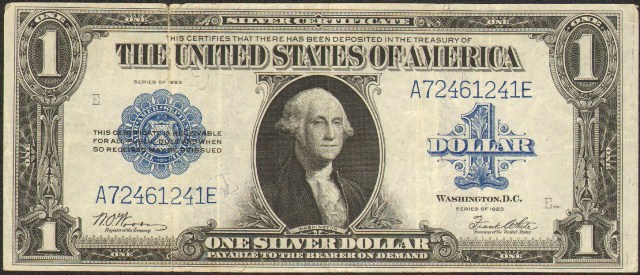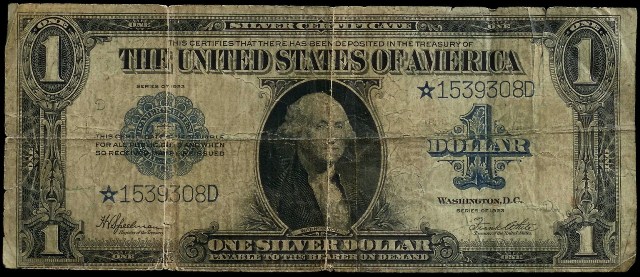Series of 1923 $1 Silver Certificate – Horse Blanket
History: The $1 silver certificate from 1923 is the single most common piece of large size United States currency. Tens of millions of these were printed and they are around by the thousands today.
There are essentially three types of 1923 $1 silver certificates:
Signed By: Speelman & White (non-star serial number) – common
Signed By: Speelman & White (star note) – semi-common
Signed By: Woods & White (non-star serial number) – common
Signed By: Woods & White (star note) – semi-common
Signed By: Woods & Tate (non-star serial number) – semi-common
Signed By: Woods & Tate (star note) – very rare
So that was your crash course introduction to 1923 $1 silver certificates. Our guide below should provide more information.
Nickname: Horse blanket is a term that is normally used to describe any large size note because they were so big they could be used to cover the back of a horse. Obviously there is a bit of hyperbole in that statement. Many people think that 1923 $1 silver certificates are called horse blankets exclusively. That is not true, but it is a good piece of information to know.
Other Facts: George Washington is featured on the 1923 $1 bill. One dollar bills from 1923 with a red seal were also issued. They are rarer and are a type of legal tender. 1923 is the last year that large size money was printed. There are many different serial number letter (block) combinations. None are considered rare or more valuable than others. There are lots of low serial number notes available. Any 1923 $1 bill with a serial number under 100 should command a premium.
Values and Grading: Condition is of the utmost importance when dealing with 1923 $1 silver certificates. You also need to consider which of the six types (listed above) that your note falls under. We are specifically discussing the common ones here.
Choice Uncirculated or Better: 1923 $1 silver certificates are so common that you can usually buy them with consecutive serial numbers. Choice uncirculated implies that the note has never been folded and that the paper is crisp and white. Most examples sell for around $100.

This Is A High Grade Woods & Tate Signature Combination Note
Extremely Fine to About Uncirculated: As a general rule of thumb, expect to spend somewhere around $50 for a nice 1923 $1 bill that might have a couple of folds.
Very Fine: Notes in very fine condition will have obvious signs of circulation, but the paper will still be crisp and relatively clean. You could go on ebay right now and spend $35 and buy a really nice looking very fine 1923 $1 silver certificate.

This $1 Silver Certificate Is In VF Condition With Woods & White Signatures
Fine and Lower: 1923 $1 silver certificates in fine and lower conditions are what you are most likely to encounter at the flea market and in coin shops. They are really only worth about $10, but everyone thinks they should be worth $100. Yes they are old and you don’t see them in circulation, but they are still very common. Fine condition implies that the paper is toned from use and wear. The paper is also going to be softer from being folded so many times. Notes in this range could also have problems like rust, writing, or tears. These are great if you are working on a budget.

Here Is A 1923 $1 Star Note Signed By Speelman & White
Need an Appraisal or Offer? We are interested in purchasing some of the rarer 1923 $1 silver certificates. We can help provide appraisals as well. Please send scans or digital photos of your bill and we can go from there. Sales@AntiqueMoney.com


